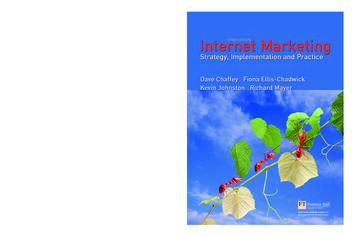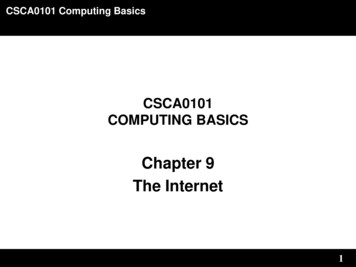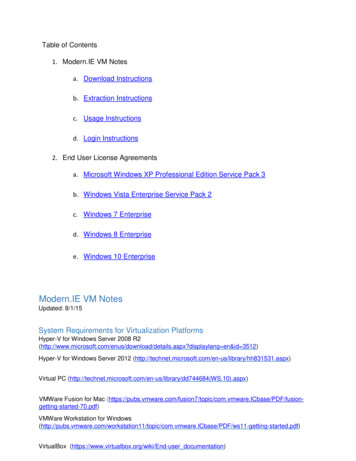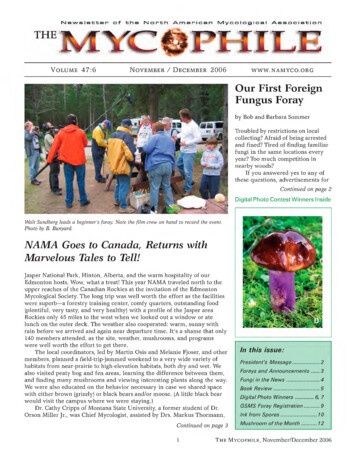
Transcription
MYC FHILEVolume47:6November / December2006www.namyco.orgOur First ForeignFungus Forayby Bob and Barbara SommerTroubled by restrictions on localcollecting? Afraid of being arrestedand fined? Tired of finding familiarfungi in the same locations everyyear? Too much competition innearby woods?If you answered yes to any ofthese questions, advertisements forContinued on page 2Digital Photo Contest Winners InsideWalt Sundberg leads a beginner's foray. Note the film crew on hand to record the event.Photo by B. Bunyard.NAMA Goes to CanadaReturns withMarvelous Tales to Tell!Jasper National Park, Hinton, Alberta, and the warm hospitality of ourEdmonton hosts. Wow, what a treat! This year NAMA traveled north to theupper reaches of the Canadian Rockies at the invitation of the EdmontonMycological Society. The long trip was well worth the effort as the facilitieswere superb—a forestry training center, comfy quarters, outstanding food(plentiful, very tasty, and very healthy) with a profile of the Jasper areaRockies only 45 miles to the west when we looked out a window or atelunch on the outer deck. The weather also cooperated: warm, sunny withrain before we arrived and again near departure time. It's a shame that only140 members attended, as the site, weather, mushrooms, and programswere well worth the effort to get there.The local coordinators, led by Martin Osis and Melanie Fjoser, and othermembers, planned a field-trip-jammed weekend to a very wide variety ofhabitats from near-prairie to high-elevation habitats, both dry and wet. Wealso visited peaty bog and fen areas, learning the difference between them,and finding many mushrooms and viewing interesting plants along the wayWe were also educated on the behavior necessary in case we shared spacewith either brown (grizzly) or black bears and/or moose. (A little black bearwould visit the campus where we were staying.)Dr. Cathy Cripps of Montana State University a former student of Dr.Orson Miller Jr., was Chief Mycologist, assisted by Drs. Markus Thormann,Continued on page 31In this issue:President's Message.2Forays and Announcements.3Fungi in the News.4Book Review.5Digital Photo Winners.6, 7GSMS Foray Registration.9ink from Spores.10Mushroom of the Month.12The Mycophile, November/December 2006
PRESIDENT'SMESSAGE( y he NAMA foray in Hinton, Alberta, was a huge success. The facilitieswere more than adequate, and what can I say about the meals? It's safe tosay that I gained a few pounds on this trip! The meals alone were worth theregistration fees. The mushrooms even cooperated, piling up on the collec tion tables in great numbers. I want to thank all of those who helped makethe foray such a great success. A special thanks to Martin Osis, MelanieFjoser, and all of the other members of the Edmonton Mycological Societywho worked hard to pull this off. Also to Louis Galick, who first approachedNAMA about coming to Alberta.Foray 2007 in West Virginia promises to be another success. If nextyear's rains come as they have this year, the mushrooms should be abun dant. A walk through the woods this past weekend yielded mushrooms inevery direction.Several items were discussed at the Trustees' meeting in Hinton.Among these was the financial condition of NAMA, which remains stable atthis time. Our year ended June 30th and resulted in a small profit for theOrganization. The archiving of NAMA materials with the New York Botani cal Gardens is nearly ready for submission. As you have noticed, Mcllvaineahas returned. Thank you, Britt and Judith. Two new clubs have become affi liated with NAMA, one in Alaska and the other in Mexico. Again this yearthe officers and trustees were challenged to contribute to NAMA's Endow ment Fund, and, as usual, they rose to the challenge, donating over 1,000of their own money to this cause. Many other issues too numerous to gointo here were discussed during the meeting, making for a full day. Manythanks need to be bestowed upon the members who serve and participate inthese meetings. If you ever have the opportunity to attend a NAMA Trust ees' meeting, you will see that these are truly dedicated individuals.Continued on page 10The Sommers in Costa Rica, continued from page 1Bob sketched thisVeloporphyrelluspantoleucus while Rolf Singerpaced impatiently waiting toput this rare specimen into hisdehydrator.foreign tours in mycology news letters will begin to look appealing.Some read like recruiting posters forthe US Army: Travel to distantplaces. Find exotic mushrooms. Pickthem.Not surprisingly, our first foreignfungus foray was also the mostmemorable. Psychologists call this a"primacy effect," like a first sightingof an Amanita muscaria. You don'tforget when and where you found it,who was with you, and your emo tional state at seeing firsthand whathas so far been only illustrations infield guides and drawings onpsychedelic posters paired withwitch's brew and frogs. Recognitionwas instantaneous. Yes, there reallyare statuesque crimson mushroomsContinued on page 11The Mycophile, November/December 20062Moving?Please send your new address,two weeks before you move, toAnn BornsteinNAMA Membership Secretary336 Lenox AvenueOakland, CA 94610-4675 Membership@namyco.org Otherwise—you may not be gettingyour newsletter for a while. Eachissue, several Mycophi/es arereturned as undeliverable because ofno forwarding address on file. NAMAis charged seventy cents for eachreturned or forwarded newsletter.NAMA is a 501(c)(3) charitableorganization. Contributions to supportthe scientific and educational activi ties of the Association are alwayswelcome and may be deductible asallowed by law. Gifts of any amountmay be made for special occasions,such as birthdays, anniversaries, andfor memorials.Special categories includeFriend of NAMA: 500-900Benefactor: 1000-4900Patron: 5000 and upSend contributions toJudith McCandless, Treasurer330 Wildwood PlaceLouisville, KY40206-2523 judithmc@iglou.com The Mycophi/e is published bimonthlyby the North American MycologicalAssociation, 6615 Tudor Court,Gladstone, OR 97027-1032.NAMA is a nonprofit corporation;contributions may be tax-deductible.Web site: www.namyco.orgIsaac Forester, NAMA PresidentRO. Box 1107North Wilkesboro, NC 28659-1107 mycoCPA@aol.com Judy Roger, Executive Secretary6615 Tudor CourtGladstone, OR 97027-1032 ExecutiveSec@namyco.org jaroger@comcast.net Britt Bunyard, Content EditorW184 N12633 Fond du Lac AvenueGermantown, Wl 53022 bbunyard@wi.rr.com Judith Caulfield, Production Editor927 Lansing DriveMt. Pleasant, SC 29464 caulfieldst@bellsouth.net
FORAYSGulf States MycologicalSociety Winter ForaySt. Francisville, LouisianaDecember 1-3For details and registration form seepage 9 in this Mycophile.37th Annual Fungus FairOakland, CaliforniaDecember 2-3Each year the Mycological Society ofSan Francisco hosts one or twomushroom shows (traditionallycalled "fungus fairs"). At the showyou will see hundreds of species offungi on display along with exhibitson ecology mycophagy, toxicology,and cultivation. Bring yourCanada Foray cont. from page 1from University of Alberta (presidentof the Edmonton Society) andLeonard Hutchison of LakeheadUniversity in Ontario. The fungiwere so numerous that manyknowledgeable attendees alsopitched in to help identify and recordthe specimens. Hope Miller was inattendance, to the delight of all, andhelped with the recordings.Hope brought along a large stackof Dr. Miller's and her newest bookMartin Osis, our Edmonton coordinator.Photo by Maggie Rogers.ANDANNOUNCEMENTScollections to our identification tablefor a free ID! The Fair will be heldat the Oakland Museum, NaturalHistory Section, 10th & Oak Streets,Oakland, CA. For additional details,see the MSSF website.Great news .Welcome Back, Tom Volk! Andfinally, it was great to see Tom Volkat a recent fall foray sponsored bymy home club, the Wisconsin Myco logical Society. In spite of the water logged conditions, Tom was climbinghills with renewed energy—thanksto his new heart—in a way reminis cent of a teen-ager. I know I speakfor all of us when I say that I'mand held a signing. There was arush to purchase the available copiesfor her signature.The programs and seminarsoffered the usual wide range oftopics, this time with special empha sis on northern boreal and highelevation habitats.I think a lot of the audience wassurprised by the tenacity and abun dance of fungi in some ratheraustere habitats—above treeline,near glaciers, and other very nonfungal appearing habitats. The leadoff program Thursday night wasabout a local Model Forest Projectand study by a multitude of resourceusers, investigating how resourcescan be extracted without harmingthe wildlife or upsetting nature'sbalances. Methinks that informationshould be widely distributed andimplemented by the parallel agenciesin this country.The Trustees' Meeting wasenlightening. Three new affiliatedclubs were recognized and wel comed: Kenai Peninsula MycologicalSociety of Soldatna; Bay Area Myco logical Society of Oakland;, andMyco Aficionados of Mexico in Tlaxcala. All the groups had had inter actions with NAMA beforehand butare now truly affiliated. Welcome!3looking forward to seeing more ofhim at future forays.And sad news . . .Elsie Louise Knighton, 88, passedaway Oct. 21, 2006 in Portsmouth,Ohio. A native of Portsmouth, shewas born April 2, 1918 to the lateJoseph Webb and Frances MaeHudson Webb. Elsie was precededin death by her husband Harry S.Knighton on May 26, 1999.Harry, founder of NAMA, andElsie were very active members ofNAMA and organized many of theannual Forays. Elsie was secretaryof NAMA for many years.Allein Stanley. Photo by Maggie Rogers.We shared a moment of silenceremembering the lives of Dr. BillCibula and Dr. Orson K. Miller, Jr.The Mushroom Dyers commit tee expressed a need for a widervariety of new supplies of dyemushrooms. They would like to askall those who find some of thesespecial fungi to collect and shipThe Mycophile,Continued on page 8November/December 2006
FUNGI IN THE NEWSThe big news, of course, is therecent NAMA Annual Foray inAlberta. It was a lot of fun, and thefood was probably the best I'veenjoyed at any foray. The scenerywas incredible, the mushroomsabundant and diverse, the wildlifeamazing (while there or on the road,my family saw every major largemammal species in North America,including mountain lions), and asMartin promised, there were nobugs! I could go on and on, but otherspace within this issue is devoted toreviews of the foray. However, Iwould like to personally thank allthe members of the Edmonton Clubfor the hospitality, and especially tothose members who were campingwith my family at Cache Per cot.Thanks for the great stories aroundthe campfire. And thanks for tolerat ing the late night antics of some ofus—you know who you are!From the Daily Telegraph in Englandcomes one more reason to disdainthose pathogenic Oomycetes. InEngland horse chestnut trees arebeing attacked by what could be theseverest threat to an arboreal speciessince Dutch elm disease. Many treesin southern England that werealready suffering from the effects ofEuropean leaf miner moths, whichattack horse chestnut leaves, nowface a more serious problem: a newform of bleeding canker that causeslesions on the bark and can destroythe tree. As many as 10% ofBritain's 500,000 horse chestnutshave been infected; an estimated3,000 have died. Canker, which iscaused by two fungi akin to potatoblight, was long thought to be undercontrol, with only four or five casesa year. However, as the new millen nium began, the number started tosoar, and it became clear that a newform of the disease had arisen.Although the pathogen is notspecifically named in the article, myguess is that it is Phytophthoraramorum. This oomycete "fungus"The Mycophile,was recently described in NorthAmerica, where it was shown tocause of Sudden Oak Death (SOD),and it is now recognized as a seriousthreat to a wide variety of trees. Adifferent strain of this pathogen isfound in Europe. Investigations areongoing, and the biology of thepathogen is still being worked out.In the latest issue of the journalMycologia (98[3j: 365-73) a team ofresearchers led by Paul Tooley, ofthe USDA at Fort Detrick in Mary land, has published the results ofone such study. The paper, "Growthand sporulation of Phytophthoraramorum in vitro in response totemperature and light," sheds lighton fundamental growth habits ofthis economically important oomy cete. Phytophthora ramorum, recentlyfound in the U.S., is causing con cern for hardwood forests and thenursery industry. In an effort toidentify some of the environmentallimitations to growth and sporula tion, the researchers conducted alaboratory study of four U.S. andthree European isolates. On V8media, isolates grew when incu bated at a wide range of temperatureand uv light conditions. P. ramorumtolerated a broad range of tempera ture and light conditions, whichsuggests why it is capable of estab lishment in a wide geographic areaand is so adaptable—and such aninvasive threat.More news from the United King dom, this time from the Daily Mail:An exotic mushroom dubbed "theelixir of long life" could be the latestweapon in the fight against cancer.A group of scientists has found thatextracts of the medicinal fungiPhellinus linteus can help in treatingprostate cancer. Previous studiesalso have suggested that the mush room extracts found on wild mul berry trees can be effective intreating liver, stomach, and lungcancer as well as other seriousconditions. The rare mushroom,November/December 20064known as "Song gen" in China and"Meshimakobu" in Japan, has longbeen known for its medicinalproperties. Sometimes marketed as"the elixir of long life," it has beenused in Oriental medicine sinceancient times.Speaking of eating mushrooms . . .Be careful what you pick and whereyou pick them. An article by L.Cocchi et al. in the latest issue of thejournal Food Chemistry (98[2j: 27784), entitled "Heavy metals in ediblemushrooms in Italy," warns ofeating mushrooms contaminatedwith toxic compounds. In this studythe distribution of arsenic, cadmium,lead, mercury, and selenium wasinvestigated in 1194 samples of 60species of common, edible mush rooms collected mainly in theprovince of Reggio Emilia, Italy. Thequantitative determination of heavymetals (mg/kg dry weight) wascarried out by spectrophotometry,with the exception of mercury,which was determined by atomicabsorption spectroscopy. The amountof arsenic accumulated in thesamples studied was generallymodest. Sarcosphaera eximia, on theother hand, may contain arsenicconcentrations reaching 1000 mg/kgdry weight. Within the Agaricussubgenus Flavoagaricus, only Agari cus nivescens contains amounts ofcadmium inferior to the allowedmaximum level. The cadmiumlevels in samples of Amanitacaesarea, Boletus edulis, and Boletuspinophilus exceeded the maximumamount allowed. (Bad news forItalians—you know how fond theyare of the porcini!) The content ofcadmium in Agaricus macrosporus isroughly 50 times the maximumweekly dose recommended by theWorld Health Organization. Theaverage amount of lead present inall samples was, in general, belowthe maximum allowed concentra tion. Agaricus bitorquis, AgaricusContinued on page 8
BOOKCommon Edible and PoisonousMushrooms of New York, by Alan E.and Arleen R. Bessette. 2006;Syracuse University Press. ISBN 08156-0848-9 (paper); 108 pp. 24.95.The latest offering from NAMAmembers and prolific book-producersAlan and Arleen Bessette is a slimbut attractive guidebook offeringadvice for those interested in eatingthe wild mushrooms of New Yorkstate while staying out of theemergency room.A brief five pages of introductorymaterial include mushroom basics,how to collect mushrooms for thetable, how to make a spore print,and how to identify mushroomsusing this book. This section isfollowed by a picture "key" to tenmain morphological groups of mush rooms: boletes, chanterelles, corals,false morels, gilled fungi, giant puff balls, Hypomyces, morels, polypores,and toothed fungi. For each group, aone-sentence description is providedalong with two example photographsand page references to the speciestreatments in the main text.Fungi in the News, cont. from page 4arvensis, Agaricus essettei, Agaricusalbertii, B. pinophilus, Clitocybegeotropa, and Macrolepiota rachodeshad high contents of mercury thatwere within the range 5-10 mg/kgdry weight. Mushrooms in general,but species in the B. edulis group inparticular, were rich in selenium. Soit's not simply what you eat, but it'salso where you pick it!From the latest issue of MycologicalResearch (110[7]: 811-20) comes apaper by Marc Stadler et al. ofGermany that looks at "Changes insecondary metabolism duringstromatal ontogeny of Hypoxylonfragiforme." Of course, Hypoxylonfragiforme is that ubiquitous crustyREVIEWThe bulk of the book comprisesthe species descriptions, separatedinto edible and inedible/poisonousones. Typically, the treatmentsappear on a two-page spread andinclude a generously sized photo graph. As we've come to expectfrom the Bessettes, the photos areuniformly excellent, showing theessential features in an attractivefashion. The text includes thescientific and common names, a listof key ID features, fruit bodydescription, time and place offruiting, edibility, and brief com ments. Twenty species are featuredin the edibles section and ten in theinedibles section. Additionally, 11edible species are mentioned incomments and illustrated in thepicture key at the front of the book.Two more edible species are men tioned in comments but not illus trated. Most of the species rangewell beyond New York state.The book concludes with guide lines for preparing and eating wildmushrooms, a selection of sevenillustrated recipes, glossary, list ofrecommended readings (of the ten,nine are by the Bessettes), andseparate indexes to common andscientific names.The strength of the book is itsquality of presentation; it is wellillustrated, attractive, informative,clearly written, and free of misspell ings and typographical errors.However, it doesn't deliver enoughto justify its price—only a bit over100 pages (many of them half whitespace) and about 40 species covered,nearly all of which you would findin many existing guides. If you'rean eastern mushroomer with at leasta few books—for instance theAudubon guide and the Bessettes'Mushrooms of Northeastern NorthAmerica—this volume will be largelysuperfluous. It will be most attrac tive to hikers and park visitors witha casual interest in mushrooms, ornovice pot-hunters, perhaps as a giftfor that friend of yours interested injoining you in your hobby.little pustule that occurs by thethousands on fallen trees and islikely one of the most commonfungal fruitbodies found in theforest. Stromata of Hypoxylonfragiforme were studied during thevegetation period, and a number ofchemical compounds were extractedand analyzed. Specifically, extractswere assayed for their nematicidaleffects against the roundwormCaenorhabditis elegans and theirantimicrobial activities against thebacteria Bacillus subtilis, Yarrowialipolyticaand various filamentousfungi. The results confirmed data inthe literature on broad-spectrumnon-selective activities of secondarymetabolites in biological systems.Most interestingly, laboratorycultures of Hypoxylon mainly pro duced dihydroisocoumarin deriva tives, of possible interest to thepharmaceutical industry. Theauthors discuss the possible biologi cal functions of secondary metabo lites in the family Hypoxyloideae.5—Steve TrudellSeattle, WashingtonIt's great to see Mushroom theJournal getting back on schedule.The summer issue was a treasuretrove, as always. Especially note worthy were articles on "Mushroom ing around the World" (a lengthytour of Tibet in search of the elusivecaterpillar fungus), an "ExistentialMushroom" (you'll never guesswhich one!), a photo essay entitled"Napolean as a Mushroom" and agreat story by Bob Sommer on fairyThe Mycophile,Continued on page 8November/December 2006
The Mycophile,November/December 20066
Documentary AwardsFirst Place:Crucibu/um laeve by David C. Work.ASecond Place:Lepiota rachodes by Charles Fonaas.BThird Place:Phaeolus schweinitzii byRichMably.CHonorable Mention: Craterellusfallax by Noah M. Siegel;Ascocoryne sarcoides by Rich Mably; Cantharellus cibarius byNoah M. Siegel; Ca/ocybe carnea by Noah M. Siegel;Coprinopsis lagopus by Donald F. Bryant; Laccaria laccata byNoah M. Siegel; Lysurusperiphragmoides by Ron J. Meyers;Agaricus by Charles Fonaas; Cortinarius by Noah M. Siegel;Spinel/us fusiger on Mycena leptocephela by Donald F. BryantPictorial AwardsFirst Place:Cortinarius vanduzerensis by Noah M. Siegel (see p. 1).DSecond Place:Amanita jacksonii by Noah M. Siegel .EThird Place:Young Polypore by David C. Work.FHonorable Mention: C/avu/inopsis fusiformis byNoah M. Siegel; Marasmiussiccus by David C. Work; Reflectionsin a Mushroom by Robert L. Kaplan; Amanita muscaria pileus byDonald F. Bryant; Fiammuiina ve/utipes by David C. Work; SlimeTaking Over the World by Noah M. Siegel; Spring BeautiesMorchella e/ata and C/aytonia caroiiniana by Noah M. Siegel;Trichaptum biformis by David C. Workl OJudges' Option CommendationsLeaf Impression in a Toothed Fungus by Robert L. KaplanGnat on Mycena aurantiodiscus by Rich Mably.Siamese Twins by Ronald J. Meyers.JOn the Internet:To view) all the digital photos that wonawards or honorable mention, go tohttp://photos.yahoo.com/namphoconand select the Photo Album entitled06 Awards.7The Mycophile,November/December 2006
Canada Foray, continued from page 3specimens for the cooking session or bring with themto the forays. It is very difficult to collect enough in herarea for such large groups, and her once abundantsupply is depleted.The Photographic Committee announced that, withthe popularity of digital cameras and demise of film/slides, there is now only one category for slides, whilethe digital section is being expanded. Watch for aformal announcement and contest entry rules inJanuary.It was decided that previous years' Mycophiles willbe available online at the www.namyco.org website.Many other topics were discussed and will bepublished when the actual minutes are published.At the general meeting on Saturday night, therecipients of the NAMA Awards were announced:Contributions to Amateur MycologyDr. Michael Beug, Toxicology Chair, longtime member,professor (retired), mentor, and all-around great guy.Cathy Cripps of Montana State U with her husband, Don Bachmanthem to the Chairs, Viola and Melanie Spock. Someregions of the country have more than others, and theywould appreciate any that can be sent their way.The Mycophagy Committee, headed by UrsulaPohl, also asked that members send her good driedKnighton AwardRichard "Dick" Dougall of the Western PennsylvaniaMycological Society, for his teaching, identifying, andpromoting the society in his region.President's AwardAnn Bornstein, Membership Secretary, for her manyyears of service.Fungi in the News, continued from page 4The official invitation to next year's Annual Foraywas given. I hope to see all of you in 2007 at Pipestem,West Virginia. As for 2008? . . . Oddsmakers are bettingon McCall, Idaho—Dr. Orson Miller's own stompinggrounds! Watch for more information as plans develop.—Judy Rogerring mushrooms. In Bob's article we learn the origin ofthe name Marasmius oreades and, more amazingly, wefind out that there is downhill skiing in Kansas! Ofcourse, there are also crosswords, word puzzles,Maggie Rogers, and numerous other reasons to pick upyour own copy!Minnesota Mushroom Poisoning—A tragic case ofmushroom poisoning occurred recently in Minnesota.The state Health Department there reports that sevenmembers of a Hmong community in the Twin Citieswere hospitalized September 9 after eating poisonousmushrooms they picked in St. Paul's Keller-PhalenRegional Park. A 10-year-old girl died on September 15;two others were still hospitalized in intensive care asthis issue went to press. All the other members of thefamily were recovering. Minnesota Mycological Societyexperts Ron Spinosa and Anna Gerenday were called tothe hospital to identify a specimen that was brought inwith the patients. The mushrooms were confirmed tohave been that of the Eastern American DestroyingAngel (Amanita bisporigera), which can easily be mis taken for nonpoisonous mushrooms, especially thepaddy straw mushroom, Volvariella volvacea, popular inSoutheast Asian cuisine. Anna recently told me thatthis case has kept her very busy, and she recently gavea presentation at a poison control center to help educatethe public on identification of poisonous mushrooms.The Mycophile,November/December 2006IDushrauf)The Journal of Wild Mushrooming4 issues (1 yr) 25; 12 issues (3 yrs) 65 (save 10)For 20 years, MTJ has provided information ofvalue to those who like to hunt, name, cook, study,and photograph wild mushrooms. We're proud ofthe job we do of reviewing books of interest tothe amateur mycologist. Our Letters column letsyou speak out and contact others to seek thatspecial book or sell that historic mushroom basket.So check us out atwww. mushroomthejournal. com8
GULF STATES MYCOLOGICAL SOCIETY WINTER FORAY"In the Footsteps of Audubon"NAMA REGIONAL FORAY December 1-3, 2006, in St. Francisville, Louisiana10. Guest mycologists will be Drs. Patrick Leacock andKentaro Hosaka, both with the Field Museum ofNatural History in Chicago. Pat's specialty is the genusLactarius, and Kentaro is an expert on the Hysterangiales, which include the stinkhorns, Gomphus, andvarious groups of false truffles. Both mycologists willgive presentations and assist with mushroom identifi cationSt. Francisville is located on Hwy. 61, about 60miles south of Natchez, MS, and about 40 miles northof Baton Rouge. RV camping is available. The nearestairports are in Baton Rouge and New Orleans, LA, andJackson, MS; major carriers serve them.Registration is limited to 50 people and/or 35 rooms.Cost of the foray is 230 for a single or 155 per personfor a double (total 310). These prices include registra tion, lodging, and meals except Saturday lunch. Youmust be a NAMA or GSMS member to attend.Located on a bluff above the Mississippi Riverfloodplain, St. Francisville has a long and colorfulhistory. Once a burial ground for Spanish monks andlater a major port between New Orleans and Natchez, itis now known for its history, close proximity to theTunica Hills, and elegant antebellum homes. We planto foray in the Hills and on the grounds of some of thehomes.John James Aububon spent 23 months in the areaas a tutor and painted 80 of his North America birdfolios here. The Oakley House, where he tutored, is thecenterpiece of the Audubon State Historic Site. Geologi cally, St. Francisville lies on loess soil bluffs, whichwere created by powerful dust storms during theGlacier Period. It is botanically diverse and is the mostsouthern location of morels along the Gulf Coast.Foray headquarters will be the Best Western-St.Francis Hotel on the Lake, U.S. Hwy. 61 at LA Hwy.REGISTRATION FORMDeadline for Registration November 22, 2006, or when rooms are filled.Name(s)AddressCity, State,ZipPhone: ( ) E-mail:SingleEHDoubleEHCoupleEHNAMA memberEHGSMS memberName of preferred roommate(s)EHPlease find me a roommateEHRegistration FeesSingle occupancy: 230. Double occupancy: 310 ( 155 per person). I preferKing bedEHTwo double bedsEHTotal. Make checks or money orders payable to Gulf States Mycological Society (GSMS).Mail to Patricia Lewis, RR 2 Box 194 L, Newton, TX 75966. Questions? Call Pat at (409) 423-3776or e-mail plewis@jas.net .We will be traveling frequently until October 23, so expect late responses. Also, sorry in advance for notgetting this into The Mycophile sooner.9The Mycophile,November/December 2006
The Production ofInk from theSpores of Fungiby Rolf SingerMany mushrooms produce sporeswith dark pigments that may beused for producing ink for calligra phy and printing. Species so em ployed are found in the generaLycoperdon, Bovista, Pisolithus, Polysaccum, and Scleroderma among theGastromycetes; also species of theUstilaginea [rusts], Elaphomycetales[truffles], and even Myxomycetes[slime molds]. But until now noexperiments have been carried outto study the serviceability andusefulness of such inks.More than 100 years ago theFrench mycologist [Jean BaptisteFrancois] Buillard [1752-93] recom mended the dung-loving species ofCoprinus [Inky Caps] for producingink. Herein is reported the satisfac tory results obtained using inksprepared from Coprinus atramentarius[the Alcohol Inky Cap] and Coprinuscomatus [the Shaggy Mane orLawyer's Wig], which are commonlyfound in gardens and other richplaces.In the Soviet Union manymushrooms with a cap possessThe Mycophile,interesting possibilities. Coprinusspecies have gills that are very closetogether and the edges of which arenot perpendicular to the stem evenupon maturity, and because of thatthe spores do not fall downward tobe spread by the wind. Instead, thegills deliquesce or dissolve andbecome smeared upon passinganimals, which spread the spores.C. atramentarius and C. comatusare the largest inky cap speciescommon in Europe and Asia. As anedible mushroom, C. comatus is goodbut it does not make as black an inkas C. atramentarius. Thus, this reportwill limit discussion to the latter.C. atramentarius has a cap that isgray-brown, furry, with centralflakes or scales upon the surface.The cap is striate and shaped like anegg or a bell 5-10 cm in diameter.The gills are at first white, thenbrown, and finally black and meltedtogether. The entire cap becomes aninky liquid. The spores are ellipsoid7.5-11 x 4.5-6.5 microns; the stemwhite and hollow; the inferior ringor annulus about the stem soondisappears. The trama or flesh of themushroom is white to gray brownand without odor. It fruits in denseclusters from May to November.[This description abridges thetechnical diagnosis in the origin
PRESIDENT'S MESSAGE (_y he NAMA foray in Hinton, Alberta, was a huge success. The facilities were more than adequate, and what can I say about the meals?
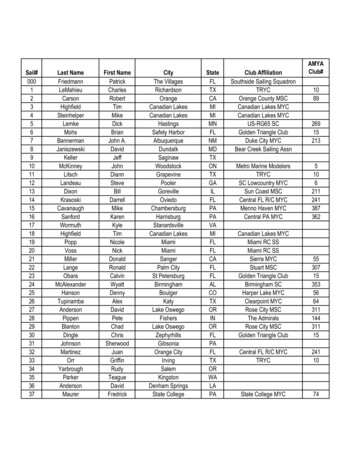
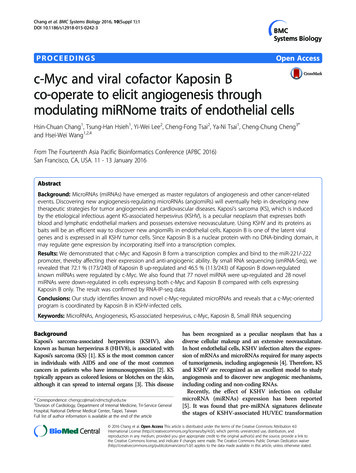
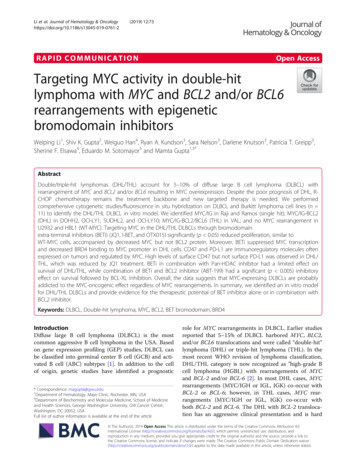
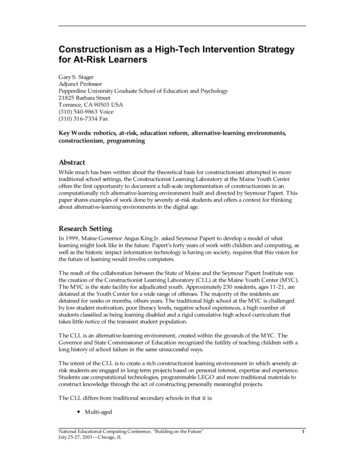
![March 3rd, 2017 [Manage Archive in Microsoft Outlook 2016]](/img/34/archive-outlook-2016.jpg)

